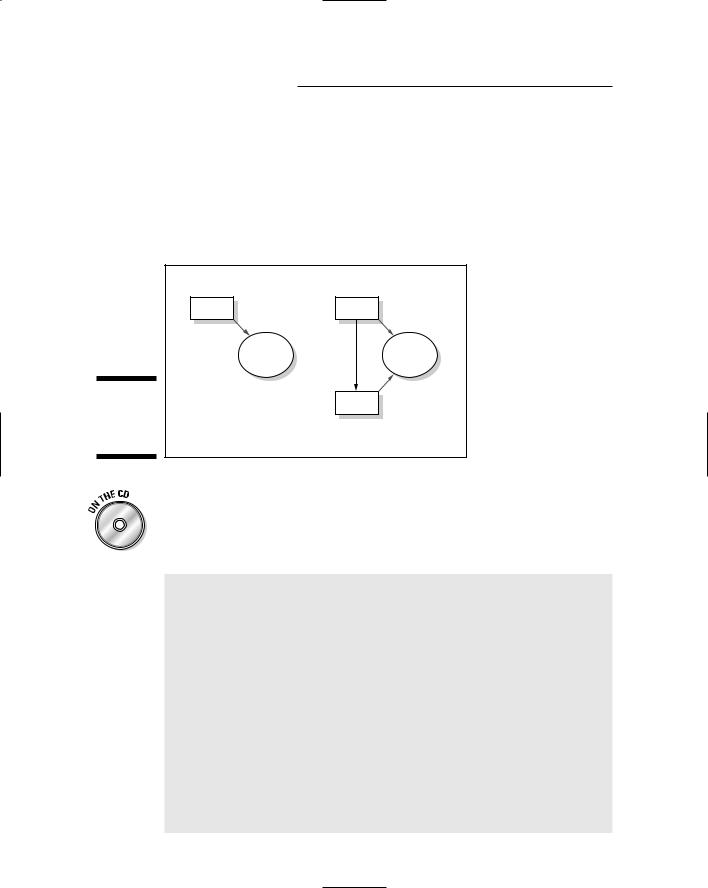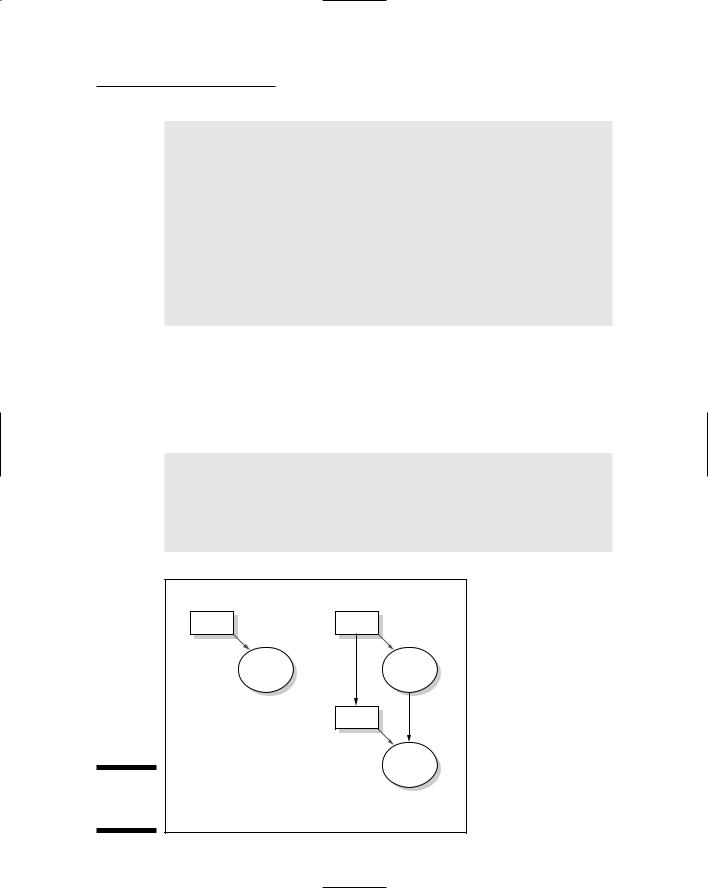
- •Table of Contents
- •Introduction
- •What Is C++?
- •Conventions Used in This Book
- •How This Book Is Organized
- •Part I: Introduction to C++ Programming
- •Part III: Introduction to Classes
- •Part IV: Inheritance
- •Part V: Optional Features
- •Part VI: The Part of Tens
- •Icons Used in This Book
- •Where to Go from Here
- •Grasping C++ Concepts
- •How do I program?
- •Installing Dev-C++
- •Setting the options
- •Creating Your First C++ Program
- •Entering the C++ code
- •Building your program
- •Executing Your Program
- •Dev-C++ is not Windows
- •Dev-C++ help
- •Reviewing the Annotated Program
- •Examining the framework for all C++ programs
- •Clarifying source code with comments
- •Basing programs on C++ statements
- •Writing declarations
- •Generating output
- •Calculating Expressions
- •Storing the results of expression
- •Declaring Variables
- •Declaring Different Types of Variables
- •Reviewing the limitations of integers in C++
- •Solving the truncation problem
- •Looking at the limits of floating-point numbers
- •Declaring Variable Types
- •Types of constants
- •Special characters
- •Are These Calculations Really Logical?
- •Mixed Mode Expressions
- •Performing Simple Binary Arithmetic
- •Decomposing Expressions
- •Determining the Order of Operations
- •Performing Unary Operations
- •Using Assignment Operators
- •Why Mess with Logical Operations?
- •Using the Simple Logical Operators
- •Storing logical values
- •Using logical int variables
- •Be careful performing logical operations on floating-point variables
- •Expressing Binary Numbers
- •The decimal number system
- •Other number systems
- •The binary number system
- •Performing Bitwise Logical Operations
- •The single bit operators
- •Using the bitwise operators
- •A simple test
- •Do something logical with logical calculations
- •Controlling Program Flow with the Branch Commands
- •Executing Loops in a Program
- •Looping while a condition is true
- •Using the for loop
- •Avoiding the dreaded infinite loop
- •Applying special loop controls
- •Nesting Control Commands
- •Switching to a Different Subject?
- •Writing and Using a Function
- •Divide and conquer
- •Understanding the Details of Functions
- •Understanding simple functions
- •Understanding functions with arguments
- •Overloading Function Names
- •Defining Function Prototypes
- •Variable Storage Types
- •Including Include Files
- •Considering the Need for Arrays
- •Using an array
- •Initializing an array
- •Accessing too far into an array
- •Using arrays
- •Defining and using arrays of arrays
- •Using Arrays of Characters
- •Creating an array of characters
- •Creating a string of characters
- •Manipulating Strings with Character
- •String-ing Along Variables
- •Variable Size
- •Address Operators
- •Using Pointer Variables
- •Comparing pointers and houses
- •Using different types of pointers
- •Passing Pointers to Functions
- •Passing by value
- •Passing pointer values
- •Passing by reference
- •Limiting scope
- •Examining the scope problem
- •Providing a solution using the heap
- •Defining Operations on Pointer Variables
- •Re-examining arrays in light of pointer variables
- •Applying operators to the address of an array
- •Expanding pointer operations to a string
- •Justifying pointer-based string manipulation
- •Applying operators to pointer types other than char
- •Contrasting a pointer with an array
- •Declaring and Using Arrays of Pointers
- •Utilizing arrays of character strings
- •Identifying Types of Errors
- •Choosing the WRITE Technique for the Problem
- •Catching bug #1
- •Catching bug #2
- •Calling for the Debugger
- •Defining the debugger
- •Finding commonalities among us
- •Running a test program
- •Single-stepping through a program
- •Abstracting Microwave Ovens
- •Preparing functional nachos
- •Preparing object-oriented nachos
- •Classifying Microwave Ovens
- •Why Classify?
- •Introducing the Class
- •The Format of a Class
- •Accessing the Members of a Class
- •Activating Our Objects
- •Simulating real-world objects
- •Why bother with member functions?
- •Adding a Member Function
- •Creating a member function
- •Naming class members
- •Calling a Member Function
- •Accessing a member function
- •Accessing other members from a member function
- •Defining a Member Function in the Class
- •Keeping a Member Function After Class
- •Overloading Member Functions
- •Defining Arrays of and Pointers to Simple Things
- •Declaring Arrays of Objects
- •Declaring Pointers to Objects
- •Dereferencing an object pointer
- •Pointing toward arrow pointers
- •Passing Objects to Functions
- •Calling a function with an object value
- •Calling a function with an object pointer
- •Calling a function by using the reference operator
- •Returning to the Heap
- •Comparing Pointers to References
- •Linking Up with Linked Lists
- •Performing other operations on a linked list
- •Hooking up with a LinkedListData program
- •A Ray of Hope: A List of Containers Linked to the C++ Library
- •Protecting Members
- •Why you need protected members
- •Discovering how protected members work
- •Protecting the internal state of the class
- •Using a class with a limited interface
- •Creating Objects
- •Using Constructors
- •Why you need constructors
- •Making constructors work
- •Dissecting a Destructor
- •Why you need the destructor
- •Working with destructors
- •Outfitting Constructors with Arguments
- •Justifying constructors
- •Using a constructor
- •Defaulting Default Constructors
- •Constructing Class Members
- •Constructing a complex data member
- •Constructing a constant data member
- •Constructing the Order of Construction
- •Local objects construct in order
- •Static objects construct only once
- •Global objects construct in no particular order
- •Members construct in the order in which they are declared
- •Destructors destruct in the reverse order of the constructors
- •Copying an Object
- •Why you need the copy constructor
- •Using the copy constructor
- •The Automatic Copy Constructor
- •Creating Shallow Copies versus Deep Copies
- •Avoiding temporaries, permanently
- •Defining a Static Member
- •Why you need static members
- •Using static members
- •Referencing static data members
- •Uses for static data members
- •Declaring Static Member Functions
- •What Is This About, Anyway?
- •Do I Need My Inheritance?
- •How Does a Class Inherit?
- •Using a subclass
- •Constructing a subclass
- •Destructing a subclass
- •Having a HAS_A Relationship
- •Why You Need Polymorphism
- •How Polymorphism Works
- •When Is a Virtual Function Not?
- •Considering Virtual Considerations
- •Factoring
- •Implementing Abstract Classes
- •Describing the abstract class concept
- •Making an honest class out of an abstract class
- •Passing abstract classes
- •Factoring C++ Source Code
- •Defining a namespace
- •Implementing Student
- •Implementing an application
- •Project file
- •Creating a project file under Dev-C++
- •Comparing Operators with Functions
- •Inserting a New Operator
- •Overloading the Assignment Operator
- •Protecting the Escape Hatch
- •How Stream I/O Works
- •The fstream Subclasses
- •Reading Directly from a Stream
- •Using the strstream Subclasses
- •Manipulating Manipulators
- •Justifying a New Error Mechanism?
- •Examining the Exception Mechanism
- •What Kinds of Things Can I Throw?
- •Adding Virtual Inheritance
- •Voicing a Contrary Opinion
- •Generalizing a Function into a Template
- •Template Classes
- •Do I Really Need Template Classes?
- •Tips for Using Templates
- •The string Container
- •The list Containers
- •Iterators
- •Using Maps
- •Enabling All Warnings and Error Messages
- •Insisting on Clean Compiles
- •Limiting the Visibility
- •Avoid Overloading Operators
- •Heap Handling
- •Using Exceptions to Handle Errors
- •Avoiding Multiple Inheritance
- •Customize Editor Settings to Your Taste
- •Highlight Matching Braces/Parentheses
- •Enable Exception Handling
- •Include Debugging Information (Sometimes)
- •Create a Project File
- •Customize the Help Menu
- •Reset Breakpoints after Editing the File
- •Avoid Illegal Filenames
- •Include #include Files in Your Project
- •Executing the Profiler
- •System Requirements
- •Using the CD with Microsoft Windows
- •Using the CD with Linux
- •Development tools
- •Program source code
- •Index

242 Part III: Introduction to Classes
the In function... message. The copied Student object copy is destruc ted at the return from fn(). The original object, randy, is destructed at the end of main().
The copy constructor here is flagged with comments to allow you to see the process. This copy constructor first copies the string Copy of into its name field. It then copies the name string from the source object s into the current object. The constructor outputs the resulting name field before returning.
The first line of output shows the chester object being created. The third line demonstrates the copy Student being generated from the copy con structor. Once within the function, it does nothing more than output a mes sage. The copy is destructed as part of the return, which generates the destructing... message.
The Automatic Copy Constructor
Like the default constructor, the copy constructor is important, important enough that C++ thinks no class should be without one. If you don’t provide your own copy constructor, C++ generates one for you. (This differs from the default constructor that C++ provides unless your class has constructors defined for it.)
The copy constructor provided by C++ performs a member-by-member copy of each data member. The copy constructor that early versions of C++ pro vided performed a bit-wise copy. The difference is that a member-by-member copy invokes all copy constructors that might exist for the members of the class, whereas a bit-wise copy does not. You can see the effects of this differ ence in the following DefaultCopyConstructor sample program. (I left out the definition of the Student class to save space — it’s identical to that shown in the CopyConstructor program. The entire DefaultCopyConstructor program is included on this book’s CD-ROM.)
//
//DefaultCopyConstructor - demonstrate that the default
// |
copy constructor invokes the |
// |
copy constructor for any member |
// |
|
#include <cstdio> #include <cstdlib> #include <iostream> using namespace std;
class Tutor
{
public:
Tutor(Student& s) : student(s) |
// |
invoke |
copy |
|
{ |
// constructor |
on |
member |
student |

Chapter 18: Copying the Copy Copy Copy Constructor 243
cout << “constructing Tutor object” << endl; id = 0;
}
protected: Student student; int id;
};
void fn(Tutor tutor)
{
cout << “In function fn()” << endl;
}
int main(int argcs, char* pArgs[])
{
Student chester(“Chester”); Tutor tutor(chester);
cout << “Calling fn()” << endl; fn(tutor);
cout << “Returned from fn()” << endl;
//wait until user is ready before terminating program
//to allow the user to see the program results system(“PAUSE”);
return 0;
}
Executing this program generates the following output:
constructed Chester constructed Copy of Chester constructing Tutor object Calling fn()
constructed Copy of Copy of Chester In function fn()
destructing Copy of Copy of Chester Returned from fn()
Press any key to continue . . .
Constructing the chester object generates the first output message from the “plain Jane” constructor. The constructor for the tutor object invokes the Student copy constructor in order to generate its own student data member. This accounts for the next two lines of output.
The program then passes a copy of the Tutor object to the function fn() (pronounced “fun,” by the way). Because the Tutor class does not define a copy constructor, the program invokes the default copy constructor to make a copy to pass to fn().
The default Tutor copy constructor invokes the copy constructor for each data member. The copy constructor for the int “class” does nothing more than copy the value. However, you’ve already seen how the Student copy

244 Part III: Introduction to Classes
constructor works. This is what generates the constructed Copy of Copy of Chester message. The destructor for the copy is invoked as part of the return from function fn().
Creating Shallow Copies versus Deep Copies
Performing a member-by-member copy seems the obvious thing to do in a copy constructor. Other than adding the capability to tack on silly things such as “Copy of “ to the front of students’ names, when would you ever want to do anything but a member-by-member copy?
Consider what happens if the constructor allocates an asset, such as memory off the heap. If the copy constructor simply makes a copy of that asset with out allocating its own, you end up with a troublesome situation: two objects thinking they have exclusive access to the same asset. This becomes nastier when the destructor is invoked for both objects and they both try to put the same asset back. To make this more concrete, consider the following example class:
//
//ShallowCopy - performing a byte-by-byte (shallow) copy
// |
is not correct when the class holds assets |
// |
|
#include <cstdio> #include <cstdlib> #include <iostream> #include <strings.h> using namespace std;
class Person
{
public: Person(char *pN)
{
cout << “constructing “ << pN << endl; pName = new char[strlen(pN) + 1];
if (pName != 0)
{
strcpy(pName, pN);
}
}
~Person()
{
cout << “destructing “ << pName << endl; strcpy(pName, “already destructed memory”); // delete pName;
}

Chapter 18: Copying the Copy Copy Copy Constructor 245
protected: char *pName;
};
void fn()
{
// create a new object
Person p1(“This_is_a_very_long_name”);
// copy the contents of p1 into p2 Person p2(p1);
}
int main(int argcs, char* pArgs[])
{
cout << “Calling fn()” << endl; fn();
cout << “Returned from fn()” << endl;
//wait until user is ready before terminating program
//to allow the user to see the program results system(“PAUSE”);
return 0;
}
This program generates the following output:
Calling fn()
constructing This_is_a_very_long_name destructing This_is_a_very_long_name
destructing already destructed memory Returned from fn()
Press any key to continue . . .
The constructor for Person allocates memory off the heap to store the person’s name, rather than put up with some arbitrary limit imposed by a fixed-length array. However, the destructor copies a message into this memory buffer rather than put it back on the heap. The main program calls the function fn(), which creates one person, p1, and then makes a copy of that person, p2. Both objects are destructed automatically when the program returns from the function.
Only one constructor output message appears when this program is executed. That’s not too surprising because the C++ provided copy constructor used to build p2 performs no output. As p1 and p2 go out of scope, you don’t receive the two output messages that you might have expected. The first destructor outputs the expected This_is_a_very_long_name. However, the second destructor indicates that the memory has already been deleted.
If you really were to delete the name, the program would become unstable after the second delete and might not even complete properly without crashing.

246 Part III: Introduction to Classes
The constructor is called once and allocates a block of memory off the heap to hold the person’s name. The copy constructor provided by C++ copies that address into the new object without allocating a new block.
The problem is shown in Figure 18-1. The object p1 is copied into the new object p2, but the assets are not. Thus, p1 and p2 end up pointing to the same assets (in this case, heap memory). This is known as a shallow copy because it just “skims the surface,” copying the members themselves.
|
p1 |
p1 |
|
|
pName |
pName |
|
|
heap |
heap |
|
|
memory |
memory |
|
Figure 18-1: |
|
p2 |
|
|
pName |
||
Shallow |
|
||
|
|
||
copy of |
Before copy |
After copy |
|
p1 to p2. |
|||
|
|
The solution to this problem is demonstrated visually in Figure 18-2. This figure represents a copy constructor that allocates its own assets to the new object. The following shows an appropriate copy constructor for class Person, the type you’ve seen up until now. (This class is embodied in the program DeepCopy, which is on this book’s CD-ROM.)
class Person
{
public: Person(char *pN)
{
cout << “constructing “ << pN << endl; pName = new char[strlen(pN) + 1];
if (pName != 0)
{
strcpy(pName, pN);
}
}
// copy constructor allocates a new heap block // from the heap
Person(Person& p)
{
cout << “copying “ << p.pName
<< “ into its own block” << endl; pName = new char[strlen(p.pName) + 1];

Chapter 18: Copying the Copy Copy Copy Constructor 247
if (pName != 0)
{
strcpy(pName, p.pName);
}
}
~Person()
{
cout << “destructing “ << pName << endl; strcpy(pName, “already destructed memory”); // delete pName;
}
protected: char *pName;
};
Here you see that the copy constructor allocates its own memory block for the name and then copies the contents of the source object name into this new name block. This is a situation similar to that shown in Figure 18-2. Deep copy is so named because it reaches down and copies all the assets. (Okay, the analogy is pretty strained, but that’s what they call it.)
The output from this program is as follows:
Calling fn()
constructing This_is_a_very_long_name
copying This_is_a_very_long_name into its own block destructing This_is_a_very_long_name
destructing This_is_a_very_long_name Returned from fn()
Press any key to continue . . .
|
p1 |
p1 |
|
pName |
pName |
|
heap |
heap |
|
memory |
memory |
|
|
p2 |
|
|
pName |
|
|
heap |
Figure 18-2: |
|
memory |
|
|
|
Deep copy |
Before copy |
After copy |
of p1 to p2. |

248 Part III: Introduction to Classes
The destructor for Person now indicates that the string pointers in p1 and p2 don’t point to common block of data. (Note, again, that the destructor out puts the most helpful “destructing...” message for debug purposes instead of actually doing anything.
It’s a Long Way to Temporaries
C++ generates a copy of an object to pass to a function by value. (This is described in the earlier sections of this chapter.) This is the most obvious but not the only example. C++ creates a copy of an object under other conditions as well.
Consider a function that returns an object by value. In this case, C++ must create a copy using the copy constructor. This situation is demonstrated in the following code snippet:
Student fn(); |
// returns object by value |
int main(int argcs, char* pArgs[]) |
|
{ |
|
Student s; |
|
s = fn(); |
// call to fn() creates temporary |
// how long does the temporary returned by fn()last? return 0;
}
The function fn() returns an object by value. Eventually, the returned object is copied to s, but where does it reside until then?
C++ creates a temporary object into which it stuffs the returned object. “Okay,” you say. “C++ creates the temporary, but how does it know when to destruct it?” Good question. In this example, it doesn’t make much difference, because you’ll be through with the temporary when the copy constructor copies it into s. But what if s is defined as a reference:
int main(int argcs, char* pArgs[])
{
Student& refS = fn();
// ...now what?...
return 0;
}
It makes a big difference how long temporaries live because refS exists for the entire function. Temporaries created by the compiler are valid throughout the extended expression in which they were created and no further.
In the following function, I mark the point at which the temporary is no longer valid:
